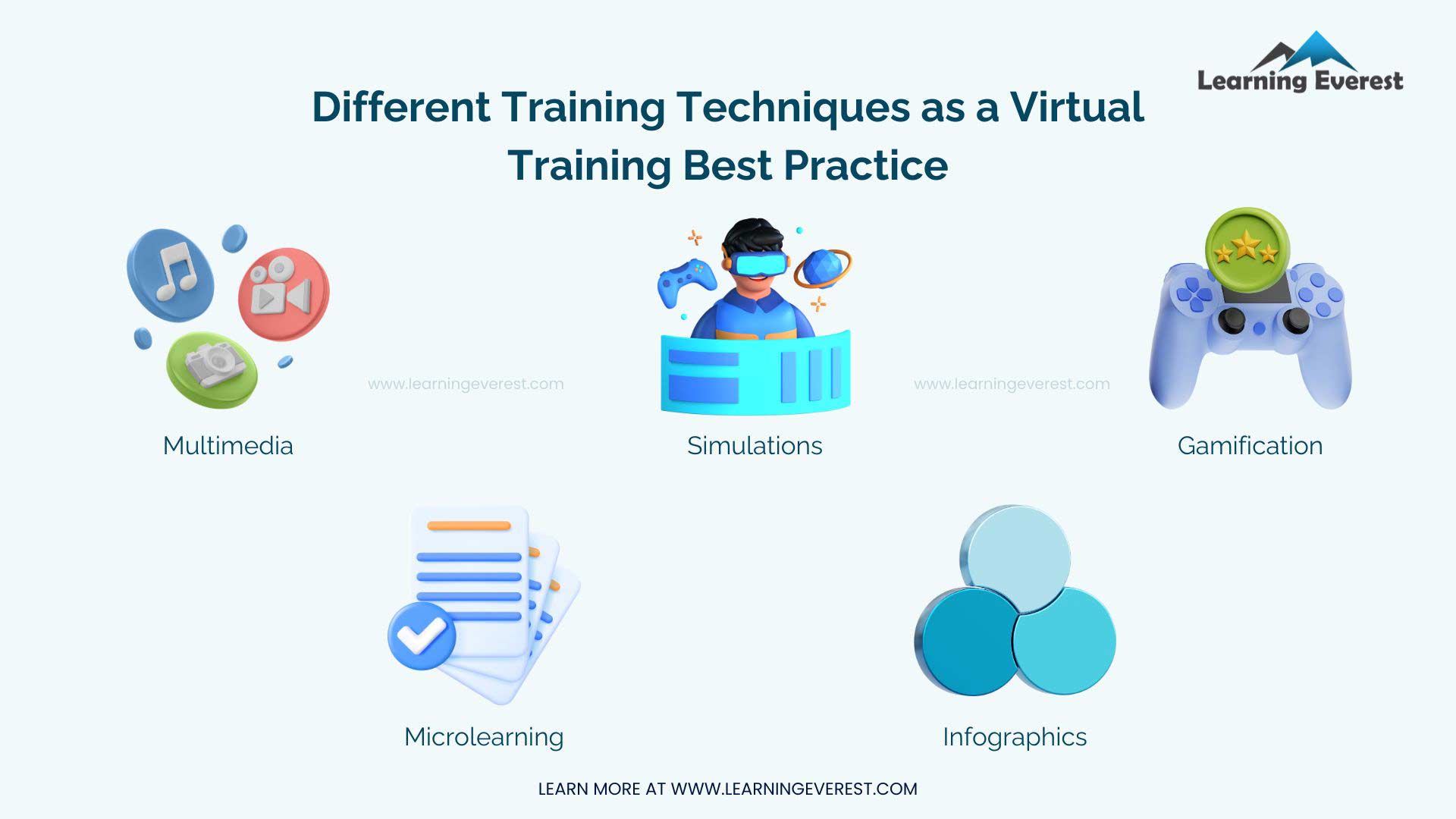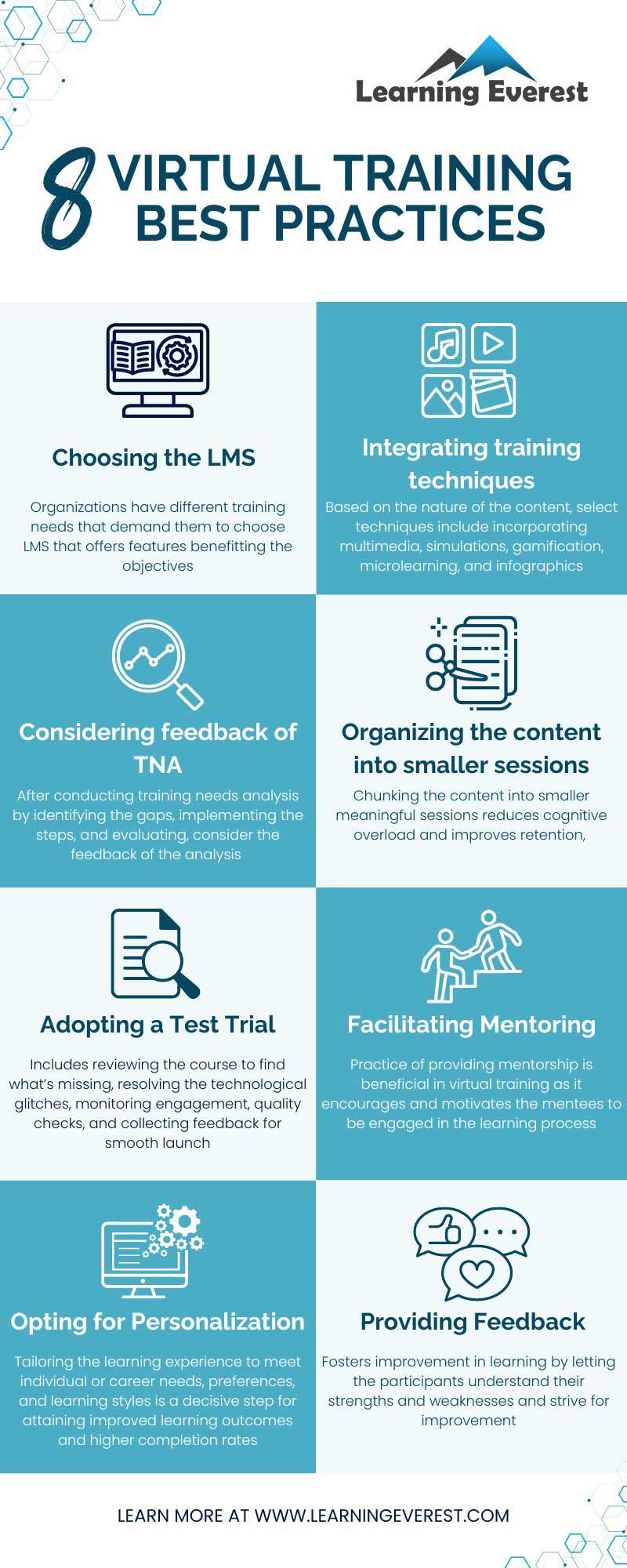Virtual Training, being the most flexible and eminent method of training is widely preferred by organizations for empowering their workforce. However, it comes with certain challenges that call for adhering to some best practices.
Table of Contents
- A Brief Insight into Virtual Training
- Here are 8 Proven Virtual Training Best Practices for Enhanced Learning
- Virtual Training Best Practice #1: Choosing the LMS
- Virtual Training Best Practice #2: Integrating training techniques
- Virtual Training Best Practice #3: Considering Feedback of Training Needs Analysis
- Virtual Training Best Practices #4: Organizing the content into small sessions
- Virtual Training Best Practices #5: Adopting a Test Trial
- Virtual Training Best Practices #6: Facilitating Mentoring
- Virtual Training Best Practices #7: Opting for Personalization
- Virtual Training Best Practices #8: Providing Continuous Feedback
- Conclusion
- Infographic
- Knowledge Check!
- Frequently Asked Questions (FAQs)
- What is virtual training?
- How to make virtual training more effective?
- What are virtual training best practices?
If you are looking for tips to make virtual training effective, here are 8 proven virtual training best practices that would highly contribute. Keep reading to discover them!
A Brief Insight into Virtual Training
Virtual training is a method of training delivered through virtual or online means enabling learners to learn from different geographical locations. Unlike the traditional method, virtual training can be conducted synchronously (real-time) and asynchronously (self-paced). With the increasing demand for learning and development, virtual training is widely preferred by organizations for their training purposes due to the immense advantages it offers. Statistics suggest that “the majority of companies are shifting to e-learning.
Around 42% of the institutions have experienced a rise in revenue as some costs, such as travel costs, have been significantly cut” (Source: Guru 99). Despite the varying pros, the lack of real face-to-face interaction is a great concern regarding virtual training. To ensure effective and engaging learning experiences, it is imperative for trainers to observe specific best practices.
Here are 8 Proven Virtual Training Best Practices for Enhanced Learning
The efficiency of every training lies in its ability to attract participants, render high-quality content, and yield the best outcomes. In a virtual learning atmosphere, where there lies a probability for learners to get distracted, it is essential to implement virtual training best practices for enhanced learning experience and retention.

Different Training Techniques as a Proven Virtual Training Best Practices
Virtual Training Best Practice #1: Choosing the LMS
An LMS or Learning Management System is a software application that provides a platform for organizing, delivering, and tracking training programs. It is a comprehensive tool that facilitates the scope of building courses, uploading training content, managing the learning process, and evaluating learner progress and overall outcomes.
Adopting LMS platforms for training practices contributes significantly to the organizations, which makes LMS stand as “the core technology platform for learning, with about 87% of companies using at least one.” (Source: Brandon Hall Group Research, 2022). Organizations have different training needs that demand them to choose LMS that offers features benefitting the objectives. In addition, factors like the extent to which LMS integrates into existing systems, scalability, and capability of customization should be considered when selecting the LMS.
Virtual Training Best Practice #2: Integrating training techniques
Training without interactive and engaging elements is monotonous and unattractive. To achieve the objectives of virtual training, designers and trainers can plan on using different techniques and channels to deliver the content effectively. The techniques include incorporating multimedia, simulations, gamification, microlearning, and infographics. In addition, adopting augmented reality, virtual reality, and AI in training can better aid the training process.
According to the State of digital learning Report 2024 published by Elucidat, “86% of L&D teams are considering using AI to assist with digital learning initiatives.” Based on the nature of the content, the trainers can decide upon selecting these techniques or opt for a combination of the methods for maximized output.
Virtual Training Best Practice #3: Considering Feedback of Training Needs Analysis
training needs analysis (TNA) refers to the “method of identifying the appropriate training required within each sector of an organization. It is the process of recognizing the parts of the organization where training is needed and addressing them one by one in a systematic, constructive, and documented manner.” After conducting training needs analysis by identifying the gaps, implementing the steps, and evaluating, considering the feedback of the analysis is a great practice for implementing virtual training. This contributes to tailoring the training program based on the abilities of learners and organizational goals.
Virtual Training Best Practices #4: Organizing the content into small sessions
To reduce cognitive overload and improve retention, chunking the content into smaller meaningful sessions is essential. This encourages the participants to comprehend the concepts effectively and I. A significant survey revealed that “58% of the employees would spend more time honing their skills at work if only the content is presented in shorter, more snackable chunks.” (Source: NikolaRoza). The lessons can be made interesting by using methods such as videos, quizzes, scenarios, interactive polls, collaborative activities, and hands-on practices. The focus on single concepts motivates learners to achieve their learning goals.
Virtual Training Best Practices #5: Adopting a Test Trial
Before implementing any virtual training program, adopting the practice of a test trial is necessary in the experimental phase. This includes reviewing the course to find what’s missing, resolving the technological glitches, monitoring engagement, quality checks, and collecting feedback. This process will prepare the smooth launching of the course by eliminating potential issues and maximizing participant satisfaction.
Virtual Training Best Practices #6: Facilitating Mentoring
Mentoring is a process of providing support and guidance to the learner by allotting a more knowledgeable person to help them develop knowledge and skills. This practice of providing mentorship is beneficial in virtual training as it encourages and motivates the mentees to be engaged in the learning process. In addition, reinforcement from the mentor contributes to building confidence in the learners to achieve higher outcomes. Due to these significant outcomes, “mentoring is now #4 on the list of learning and development strategies that L&D teams are considering” according to the 2022 L&D Global Sentiment Survey. (Source: Donald H Taylor).
Virtual Training Best Practices #7: Opting for Personalization
Personalized Instruction is a crucial practice for increased effectiveness of virtual training that includes tailoring the learning experience to meet individual or career needs, preferences, and learning styles of the learners. In a virtual setup, personalizing the learning content is a decisive step for attaining improved learning outcomes and higher completion rates.
Virtual Training Best Practices #8: Providing Continuous Feedback
For the success of every virtual training, it is necessary to provide the learners with real-time feedback on their performance, progress, and areas of improvement. Feedback fosters improvement in learning by letting the participants understand their strengths and weaknesses and strive for improvement. Furthermore, the training program can be made effective by gathering regular feedback from the participants concerning the techniques implemented, the efficiency of the training content, the level of comprehension, and suggestions for improvement. In this manner, feedback is an inevitable component of impactful virtual training.
Conclusion
Virtual training is the most preferred mode of training due to its flexibility and affordability. To ensure the efficiency of this online mode of training, 8 virtual training best practices can be implemented.
They are choosing the apt LMS aligning with the training goals, integrating various training techniques such as multimedia, simulations, gamification, microlearning, and infographics, conducting training needs analysis and considering its feedback, dividing the content into small meaningful sessions to attract and retain the attention of the participants, adopting a test trial to identify the flaws before implementing the training program, facilitating mentoring programs to motivate the mentees to stay engaged in learning, personalizing the learning content based on individual or career needs and learning styles of the learners, and providing and gathering regular feedback to ensure the efficiency of the program.
It is suggested that designers as well as trainers engaged in training programs adopt the best practices in their virtual training to maximize the learning outcomes.
Infographic
Knowledge Check!
Frequently Asked Questions (FAQs)
What is virtual training?
Virtual training is a method of training delivered through virtual or online means enabling learners to learn from different geographical locations.
How to make virtual training more effective?
To make the virtual training more effective, 8 virtual training best practices can be implemented. They are choosing the apt LMS aligning with the training goals, integrating various training techniques such as multimedia, simulations, gamification, microlearning, and infographics, conducting training needs analysis and considering its feedback, dividing the content into small meaningful sessions to attract and retain the attention of the participants, adopting a test trial to identify the flaws before implementing the training program, facilitating mentoring programs to motivate the mentees to stay engaged in learning, personalizing the learning content based on individual or career needs and learning styles of the learners, and providing and gathering regular feedback to ensure the efficiency of the program.
What are virtual training best practices?
8 virtual training best practices are choosing the right LMS, integrating various training techniques, considering the feedback of TNA, organizing content into smaller sessions, adopting a test trial, facilitating mentoring, personalizing the learning content, and providing continuous feedback.







